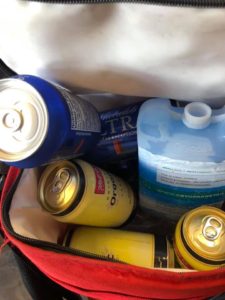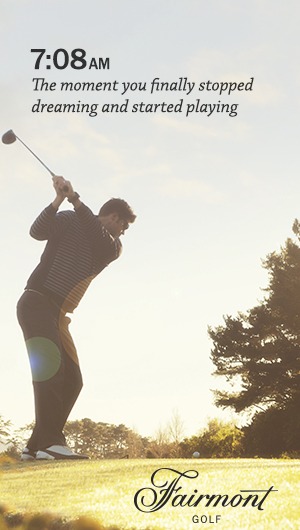“Public service announcement: In Ontario it is illegal to bring your own alcohol to a licensed establishment. We have a zero tolerance at Seguin Valley. This was removed from our customers prior to playing today. Guests, we will ask you to leave without a refund. Be aware.”
 And so with that Facebook post from Seguin Valley GC General Manager Gail Burrows, issued Sept. 5 along with the accompanying image of a cooler bag full of beer, a heated online discussion commenced about the practice of confiscating smuggled alcohol, as well as potentially removing players from the golf course without a raincheck.
And so with that Facebook post from Seguin Valley GC General Manager Gail Burrows, issued Sept. 5 along with the accompanying image of a cooler bag full of beer, a heated online discussion commenced about the practice of confiscating smuggled alcohol, as well as potentially removing players from the golf course without a raincheck.
The legend goes that the measure of a standard round of golf was determined by some old Scot who rationed himself to a shot of whisky per hole, arriving at 18 holes until the bottle was drained. Folklore, of course, but it seems that the simultaneous enjoyment of golf and inebriants have indeed been intertwined for centuries. And there is likely no other ‘sport’ that embraces the consumption of alcohol during play quite the way that golf does.
One of the responders to Burrows’ comment, in fact, observed, “When I played the other day they told us in the pro shop told us there was no cart girl—that was last minute. Dry, for 18 holes! Nice!”
There were, indeed, alcoholic beverages dispensed at the clubhouse at the turn, but the comment inferred that the very concept of playing golf without raising your blood-alcohol level was both abhorrent and inconceivable. And that opinion is somewhat pervasive. After all, for many avid linksters, golf is more of a social outing than a competitive exercise—meaning enjoying a few wobbly pops along the way is a welcome offshoot. And that presents a challenge for golf course managers tasked with protecting both customers and themselves—particularly when they’re not aware of all the alcohol those patrons are consuming.
LAW OF THE LAND
The Alcohol and Gaming Commission of Ontario (AGCO) is responsible for administering the Liquor Licence Act (LLA) and specific sections of the Liquor Control Act (LCA). Under the LLA, licensees—including golf clubs—are required to ensure that alcohol is sold, served and consumed in a responsible manner.
“There are two elements to a golf club’s liquor sales licence: the liquor sales licence itself (to sell and serve liquor in the clubhouse, restaurant, outdoor patios, etc.) and a Golf Course Endorsement, which allows the club to sell and serve alcohol on the playing area of a golf course,” explains Raymond Kahnert, Senior Advisor in the Communications and Corporate Affairs Division of the AGCO. “AGCO Compliance Officials do visit golf courses across Ontario and conduct inspections. As part of that inspection, the Compliance Official may attend multiple areas of the golf course including the clubhouse and playing area. During these inspections, we will verify that a licensee is operating in compliance with the LLA and its applicable regulations. As an example, AGCO Compliance Officials will inspect to verify that the licensee is not permitting drunkenness, allowing service to minors, allowing Illegal liquor on premise or serving outside the prescribed hours.
“We do work with all licensed establishments to help them understand their obligations under the LLA. It is up to these licensees to implement measures to ensure that they are in compliance with the law,” Kahnert continues. “If a golf course is unable or unwilling to comply with the LLA, the AGCO can take regulatory action. This can include a verbal warning, a written warning, a temporary suspension of the licence or, in the most serious cases, a revocation of their liquor licence.”
Part of that responsibility entails preventing anyone from opening and consuming their own liquor on the golf course. And if you don’t think that’s fair and want to complain about the on-course markup on beers and cocktails, try walking into Scotiabank Arena for a Toronto Maple Leafs game—well, the next time you can actually do that anyway—with a six-pack loaded in your padded cooler bag and see how far you get. And then try asking for your money back as you’re being removed from the premises.
A requirement for courses to effectively implement such procedures should ideally include a written policy on their websites, including reserving the right to inspect golf bags and cooler bags. Wooden Sticks GC in Uxbridge, for example, lists the following on its COVID-19 Update page: “Important Notice: All alcohol must be purchased from the course hospitality stations or clubhouse. The policy adheres to all legislated liquor laws and our liquor licenses. Unauthorized alcohol on the property including in golf bags will be confiscated. Personal coolers will not be allowed.”
Although many patrons are more conscious than ever about access to safe drinking water during these pandemic times, a cooler bag always sends out warning signals to course operators, including the one spotted (and photographed) by Burrows last week.
DEALING WITH RULEBREAKERS
“I was in the liquor cart and when I pulled up I could see it was a brand of beer we don’t have,” Burrows relates. “Usually how it goes is you pull up in the refreshment cart and they say, ‘No, we’re fine, we’re fine!’ Most servers will keep on trucking, but I said, ‘Oh, you’re fine? You’re on the second tee and this will probably be my last round of the day. But I see you have short cans, and we don’t sell that brand. Do you have any more with you?’
“‘Oh ya, we brought a six-pack for each of us.’
“I said, ‘Oh, really? You understand it’s illegal to bring your own alcohol?’
“‘Well, I didn’t see that on your website,’ they’ll say. And I’m like, ‘Oh buddy, I know it is, because I designed the website. And it’s illegal throughout the whole province. It’s also on the sign at the first tee, and it’s on the scorecard. Tell you what I’m going to do—I’m going to take your cooler bag and you can pick it up and take it home with you, but you can’t have illegal alcohol on the golf course.’
“I let them finish the round,” Burrows adds. “Those folks openly admitted it and gave it to me immediately. The other people I encountered that Saturday were on the green and their cart was on the path and I took everything visible in their cart and dumped it so they could see me dumping it out.”
Anita-Simon-Pickett, Vice-President of Operations & Marketing at Crosswinds GC in Burlington, has taken special measures to alert guests of the laws of the land, including three separate emails when you book a time: one upon booking, a reminder that follows afterward, and a third email she sends herself—each reminding guests of the golf course policy, which includes zero tolerance for smuggling in alcohol.
“We have a big sign on the first tee too,” Simon-Pickett says. “I send multiple messages through our GPS system that come up on the cart screen: ‘You’re not allowed to bring your own alcohol.’ So people can’t say they didn’t know, since I can tell them, ‘You pressed ‘yes’ at 10:25 a.m.’ Even if they say they didn’t read it, they acknowledged it.
“We’ve done emails when you book since we got our system in 2016, but this is the first year we’ve said we’d remove you from the course if you’re caught,” Simon-Pickett says. “It’s now zero tolerance. You can’t just pour it out or give it to us.
“Golf courses are legally liable if something happens,” she reminds. “We’ve had liquor inspectors come by and I’ve driven out on the course with them. They didn’t find any when I was with them, but you can get a warning or lose your liquor license. We have weddings, tournaments, banquets, a restaurant—we can’t risk losing our license.”
Simon-Pickett has often offered rainchecks for players that have been asked to leave, an admittedly expensive endeavour, given it’s $312 for a foursome in prime time—a tee time they would almost assuredly have sold to four other players this busy season—players who would likely have made legal food and beverage purchases themselves.
“We’re 50/50 giving rainchecks,” she admits. “It’s sort of the cost of doing business. Most who get caught are embarrassed. Usually they’ll plead, ‘We’ll buy beer from you.’ But I’m like, ‘That’s not the point! I don’t know how many you’ve had already! I can’t sell you more beer!’ It’s about keeping people safe; not about selling more beer.
“I think some courses that don’t have liquor licenses have quietly turned a blind eye,”suggests Simon-Pickett, who says they consistently find beer they don’t sell in the trash cans. “We can’t catch everybody. It’s maybe once or twice a week, so not a huge problem, but some might be putting empties in their golf bags, so you’ll never know.”
The frustration is amped up with golf courses across Ontario already taking added measures—and expenses—to protect their patrons from contracting COVID-19, including expanding gaps between tee times and continually sanitizing carts and touch points throughout their facilities. Alcohol, however, invariably lowers people’s barriers. “After a couple of beers, you start to see players high-fiving each other,” Simon-Pickett observes.
BATTLING MINDSETS
It will always be difficult getting around the social drinking mindset of many players, Burrows concedes. “It’s true, people have this expectation that if you’re going to play the game you’ve gotta drink six beer while you’re at it,” she says. “Even golf equipment manufacturers are making it easier to bring your own by designing golf bags with large cooler pockets.”
Monitoring alcohol intake takes on added importance at a course like Seguin, with its dramatic twists, turns and elevation changes making the responsible driving of power carts paramount. “Especially on the back nine, which has our most dangerous holes,” Burrows says. “I have a stack of reports here of damaged carts that I‘m trying to collect funds for from players who have crashed them.
“Last year was bad (for smuggling), mostly because a lot of people were pairing up with the Ridge at Manitou (Golf Club), and they didn’t have a liquor license at the time,” Burrows notes. “But this year, because of the sheer increased volume of people, we’re seeing people bringing in their own alcohol a lot more. Garbage cans are full every day with other people’s drinks. And if they’re not putting it in the cans, they’re throwing it in the trees—many seem have no regard for that rule whatsoever. I’m not sure what other courses are doing to mitigate it.
“Staff are well aware of their roles,” Burrows assures. “All they have to do is serve players one beer and if they’ve had 10 of their own and get into an accident, you’re still liable. And as GM, I’m liable for my staff. From a business perspective, there are huge implications. Consumers often don’t see it the same way, though. For many the thinking is that if something were to happen, they’re protected because the business is liable.
“But it’s interesting—if you follow AGCO rulings, you don’t see a lot of courses being charged, so there’s no real pressure from the Liquor Control Board for businesses,” says Burrows. “It’s only a matter of time before something happens.”
“I haven’t forced my staff to kick people off—more monitoring them than kicking them out,” Burrows says. “But it’s come to the point where we need to start making examples of customers. But every course has got to be doing it.”
Another popular public golf facility, requesting anonymity, also believes the problem needs to be more forcefully addressed. “We are going to revisit all policies for next year,” a written statement from the Central Ontario course noted. “Even though we feel we catch and minimize most offenders, we know that there are some that get away with it. We have had to be ‘in your face’ about these policies more than ever this year and we will continue to educate.”
“Golf course operators remember the Lake Joseph Club incident,” says Simon-Pickett of the 2008 car accident that claimed three young men after drinking at the Muskoka facility. “It’s something we never want to see again. So you do your best to make sure it doesn’t happen again.”
It will take their best—and that of every Ontario course across the board. Because if the primary penalty of consuming your own private alcohol merely remains its temporary impounding until your round is complete, many golfers will continue to believe that, in the risk-reward landscape of golf, this shot is still worth the risk.




2 Comments
Leave your reply.